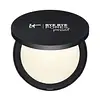What's inside
What's inside
 Key Ingredients
Key Ingredients

 Benefits
Benefits

 Concerns
Concerns

 Ingredients Side-by-side
Ingredients Side-by-side

Water
Skin ConditioningAlcohol Denat.
AntimicrobialGlycerin
HumectantPropanediol
SolventSilica
AbrasivePhenoxyethanol
PreservativeMethyl Methacrylate Crosspolymer
Kaolin
AbrasiveZinc Gluconate
Skin ConditioningAloe Barbadensis Leaf Juice Powder
Skin ConditioningParfum
MaskingMenthoxypropanediol
MaskingCocos Nucifera Fruit Juice
EmollientHamamelis Virginiana Water
AstringentAllantoin
Skin ConditioningHydrolyzed Silk
HumectantAvena Sativa Kernel Flour
AbrasiveLinalool
PerfumingSalicylic Acid
MaskingPropylene Glycol
HumectantPentylene Glycol
Skin ConditioningHydrolyzed Rice Protein
Skin ConditioningLimonene
PerfumingCitric Acid
BufferingSoluble Collagen
HumectantSodium Benzoate
MaskingPotassium Sorbate
PreservativeDisodium EDTA
Trisodium EDTA
Water, Alcohol Denat., Glycerin, Propanediol, Silica, Phenoxyethanol, Methyl Methacrylate Crosspolymer, Kaolin, Zinc Gluconate, Aloe Barbadensis Leaf Juice Powder, Parfum, Menthoxypropanediol, Cocos Nucifera Fruit Juice, Hamamelis Virginiana Water, Allantoin, Hydrolyzed Silk, Avena Sativa Kernel Flour, Linalool, Salicylic Acid, Propylene Glycol, Pentylene Glycol, Hydrolyzed Rice Protein, Limonene, Citric Acid, Soluble Collagen, Sodium Benzoate, Potassium Sorbate, Disodium EDTA, Trisodium EDTA
Zinc Oxide 12%
Cosmetic ColorantWater
Skin ConditioningSqualane
EmollientShea Butter Ethyl Esters
EmollientIsoamyl Laurate
EmollientPolyglyceryl-3 Ricinoleate
EmulsifyingButyloctyl Salicylate
Skin ConditioningPropanediol
SolventIsopropyl Isostearate
EmollientPolyglyceryl-3 Diisostearate
EmulsifyingMethylpropanediol
SolventNiacinamide
SmoothingSodium Chloride
MaskingLecithin
EmollientCaprylyl Glycol
EmollientSilica
AbrasiveAloe Barbadensis Leaf Juice Powder
Skin ConditioningBisabolol
MaskingHydrolyzed Sodium Hyaluronate
Skin ConditioningAllantoin
Skin ConditioningPhenylpropanol
MaskingSodium Myristoyl Glutamate
CleansingSodium Hyaluronate
HumectantTetrasodium Glutamate Diacetate
Aluminum Hydroxide
EmollientPolyhydroxystearic Acid
EmulsifyingCI 77491
Cosmetic ColorantCI 77492
Cosmetic ColorantCI 77499
Cosmetic ColorantCI 77891
Cosmetic ColorantZinc Oxide 12%, Water, Squalane, Shea Butter Ethyl Esters, Isoamyl Laurate, Polyglyceryl-3 Ricinoleate, Butyloctyl Salicylate, Propanediol, Isopropyl Isostearate, Polyglyceryl-3 Diisostearate, Methylpropanediol, Niacinamide, Sodium Chloride, Lecithin, Caprylyl Glycol, Silica, Aloe Barbadensis Leaf Juice Powder, Bisabolol, Hydrolyzed Sodium Hyaluronate, Allantoin, Phenylpropanol, Sodium Myristoyl Glutamate, Sodium Hyaluronate, Tetrasodium Glutamate Diacetate, Aluminum Hydroxide, Polyhydroxystearic Acid, CI 77491, CI 77492, CI 77499, CI 77891
 Reviews
Reviews

Ingredients Explained
These ingredients are found in both products.
Ingredients higher up in an ingredient list are typically present in a larger amount.
Allantoin is a soothing ingredient known for its protective and moisturizingg properties. Because of this, it is often added to products with strong active ingredients.
Studies show higher concentrations of this ingredient can promote wound healing.
Though it can be derived from the comfrey plant, allantoin is produced synthetically for cosmetic products to ensure purity.
Learn more about AllantoinAloe Barbadensis Leaf Juice Powder comes from the aloe plant.
You may know Aloe to be a good sunburn reliever and inflammation reducer. This is because it contains many components that are known to help reduce irritation and itchiness.
Aloe leaves are also great moisturizers. They are naturally rich in polysaccharides, a carbohydrate made of sugars. Polysaccharides are able to mimic the carbs found in the top layer of your skin. This can help keep your skin hydrated.
Aloe contains the antioxidants Vitamins A, C, and E. These vitamins neutralize free radicals. Free-radicals are molecules that may damage your skin cells, such as pollution.
Aloe does not protect against UV rays, despite it soothing sunburns.
Learn more about Aloe Barbadensis Leaf Juice PowderPropanediol is an all-star ingredient. It softens, hydrates, and smooths the skin.
It’s often used to:
Propanediol is not likely to cause sensitivity and considered safe to use. It is derived from corn or petroleum with a clear color and no scent.
Learn more about PropanediolSilica, also known as silicon dioxide, is a naturally occurring mineral. It is used as a fine, spherical, and porous powder in cosmetics.
Though it has exfoliant properties, the function of silica varies depending on the product.
The unique structure of silica enhances the spreadability and adds smoothness, making it a great texture enhancer.
It is also used as an active carrier, emulsifier, and mattifier due to its ability to absorb excess oil.
In some products, tiny microneedles called spicules are made from silica or hydrolyzed sponge. When you rub them in, they lightly polish away dead skin layers and enhance the penetration of active ingredients.
Learn more about SilicaWater. It's the most common cosmetic ingredient of all. You'll usually see it at the top of ingredient lists, meaning that it makes up the largest part of the product.
So why is it so popular? Water most often acts as a solvent - this means that it helps dissolve other ingredients into the formulation.
You'll also recognize water as that liquid we all need to stay alive. If you see this, drink a glass of water. Stay hydrated!
Learn more about Water